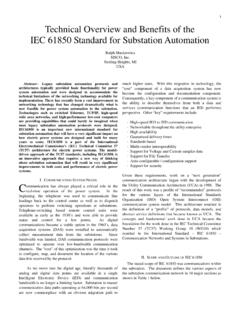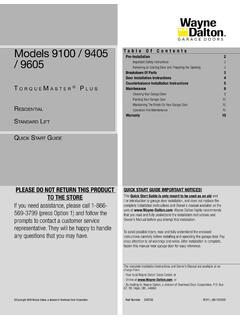Transcription of Standard Definitions - AAPOR
1 Standard Definitions Final Dispositions of Case Codes and Outcome Rates for Surveys Revised 2016 RDD Telephone Surveys In-Person Household Surveys Mail Surveys of Specifically Named Persons Mail Surveys of Unnamed Persons Internet Surveys of Specifically Named Persons 201 6 THE AMERICAN ASSOCIATION FOR PUBLIC OPINION RESEARCH 1 Table of Contents About this report / citations .. 2 Background .. 4 Introduction .. 7 Final disposition codes .. 7 RDD Telephone Surveys of Households .. 13 In-Person Household Surveys .. 22 Mail Surveys of Specifically Named Persons .. 27 Mail Surveys of Unnamed Persons.. 34 Internet Surveys of Specifically Named Persons .. 42 Mixed-Mode Surveys.. 50 Establishment Surveys.
2 51 Calculating rates from response distributions .. 60 Response rates .. 60 Cooperation rates .. 62 Refusal rates .. 63 Contact rates .. 64 Reporting Outcome Rates .. 64 Some Complex Designs .. 65 Conclusion .. 68 References .. 70 Tables Table 1 - Final Disposition Codes for RDD Telephone Surveys .. 74 Table 2 - Final Disposition Codes for In-Person, Household Surveys .. 75 Table 3 - Final Disposition Codes for Mail Surveys of Specifically Named Persons .. 76 Table 4 Final Disposition Codes for Mail Surveys of Unnamed Persons .. 77 Table 5 Final Disposition Codes for Internet Surveys of Specifically Named Persons.. 78 AAPOR Press Release on Response Rates .. 79 2 About this report Standard Definitions is a work in progress; this is the ninth major edition.
3 The American Association for Public Opinion Research plans to continue updating it, adding comparable Definitions for other modes of data collection and making other refinements. AAPOR also is working with other organizations to further the widespread adoption and utilization of Standard Definitions . AAPOR is seeking the cooperation of companies that provide computer-assisted telephone interviewing (CATI) software. Some of these companies already have agreed to incorporate the Definitions and formula into their software reports. AAPOR also is asking academic journals to use AAPOR standards in their evaluation and publication of articles; several, including Public Opinion Quarterly and the International Journal of Public Opinion Research, already have agreed to do so.
4 The first edition (1998) was based on the work of a committee headed by Tom W. Smith. Other AAPOR members who served on the committee include Barbara Bailar, Mick Couper, Donald Dillman, Robert M. Groves, William D. Kalsbeek, Jack Ludwig, Peter V. Miller, Harry O Neill, and Stanley Presser. The second edition (2000) was edited by Rob Daves, who chaired a group that included Janice Ballou, Paul J. Lavrakas, David Moore, and Smith. Lavrakas led the writing for the portions dealing with mail surveys of specifically named persons and for the reorganization of the earlier edition. The group wishes to thank Don Dillman and David Demers for their comments on a draft of this edition. The third edition (2004) was edited by Smith who chaired a committee of Daves, Lavrakas, Daniel M.
5 Merkle, and Couper. The new material on complex samples was mainly contributed by Groves and Mike Brick. The fourth edition was edited by Smith who chaired a committee of Daves, Lavrakas, Couper, Shap Wolf, and Nancy Mathiowetz. The new material on Internet surveys was mainly contributed by a sub-committee chaired by Couper with Lavrakas, Smith, and Tracy Tuten Ryan as members. The fifth edition was edited by Smith who chaired the committee of Daves, Lavrakas, Couper, Mary Losch, and J. Michael Brick. The new material largely relates to the handling of cell phones in surveys. The sixth edition was edited by Smith who chaired the committee of Daves, Lavrakas, Couper, Reg Baker, and Jon Cohen. Lavrakas led the updating of the section on postal codes.
6 Changes mostly dealt with mix-mode surveys and methods for estimating eligibility rates for unknown cases. The seventh edition was edited by Smith who chaired the committee of Daves, Lavrakas, Couper, Timothy Johnson, and Richard Morin. Couper led the updating of the section on internet surveys and Sara Zuckerbraun drafted the section on establishment surveys. The eighth edition was edited by Smith who chaired the committee of Daves, Lavrakas, Couper, and Johnson. The revised section on establishment surveys was developed by Sara Zuckerbraun and Katherine Morton. The new section on dual-frame telephone surveys was prepared by a sub-committee headed by Daves with Smith, David Dutwin, Mario Callegaro, and Mansour Fahimi as members. The ninth edition was edited by Smith who chaired the committee of Daves, Lavrakas, Couper, Johnson, and Dutwin.
7 The new section on mail surveys of unnamed person was prepared by a sub-committee headed by Dutwin with Couper, Daves, Johnson, Lavrakas, and Smith as members. How to cite this report This report was developed for AAPOR as a service to public opinion research and the 3 survey research industry. Please feel free to cite it. AAPOR requests that you use the following citation: The American Association for Public Opinion Research. 2016. Standard Definitions : Final Dispositions of Case Codes and Outcome Rates for Surveys. 9th edition. AAPOR . 4 Background For a long time, survey researchers have needed more comprehensive and reliable diagnostic tools to understand the components of total survey error. Some of those components, such as margin of sampling error, are relatively easily calculated and familiar to many who use survey research.
8 Other components, such as the influence of question wording on responses, are more difficult to ascertain. Groves (1989) catalogues error into three other major potential areas in which it can occur in sample surveys. One is coverage, where error can result if some members of the population under study do not have a known nonzero chance of being included in the sample. Another is measurement effect, such as when the instrument or items on the instrument are constructed in such a way to produce unreliable or invalid data. The third is nonresponse effect, where nonrespondents in the sample that researchers originally drew differ from respondents in ways that are germane to the objectives of the survey. Defining final disposition codes and calculating call outcome rates is the topic for this booklet.
9 Often it is assumed correctly or not that the lower the response rate, the more question there is about the validity of the sample. Although response rate information alone is not sufficient for determining how much nonresponse error exists in a survey, or even whether it exists, calculating the rates is a critical first step to understanding the presence of this component of potential survey error. By knowing the disposition of every element drawn in a survey sample, researchers can assess whether their sample might contain nonresponse error and the potential reasons for that error. With this report, AAPOR offers a new tool that can be used as a guide to one important aspect of a survey s quality. It is a comprehensive, well-delineated way of describing the final disposition of cases and calculating outcome rates for surveys conducted by telephone, for personal interviews in a sample of households, and for mail surveys of specifically named persons ( , a survey in which named persons are the sampled elements).
10 For this third mode, this report utilizes the undelivered mail codes of the United States Postal Service (USPS) which were in effect in 2000. AAPOR hopes to accomplish two major changes in survey research practices. The first is standardizing the codes researchers use to catalogue the dispositions of sampled cases. This objective requires a common language, and Definitions that the research industry can share. AAPOR urges all practitioners to use these codes in all reports of survey methods, no matter if the project is proprietary work for private sector clients or a public, government or academic survey. This will enable researchers to find common ground on which to compare the outcome rates for different surveys. Linnaeus noted that method [is] the soul of science.




